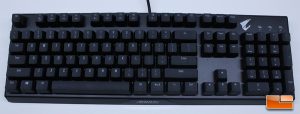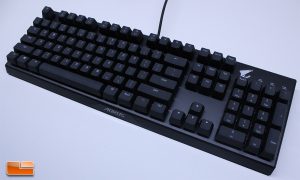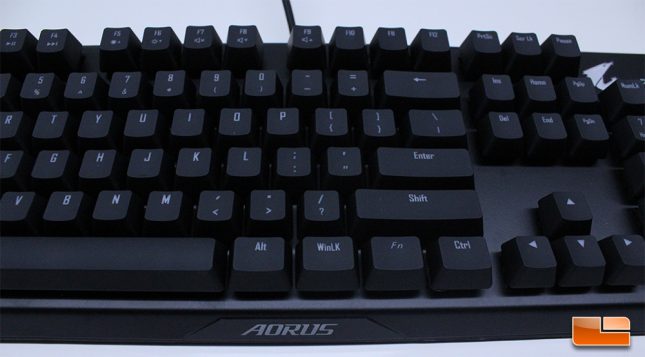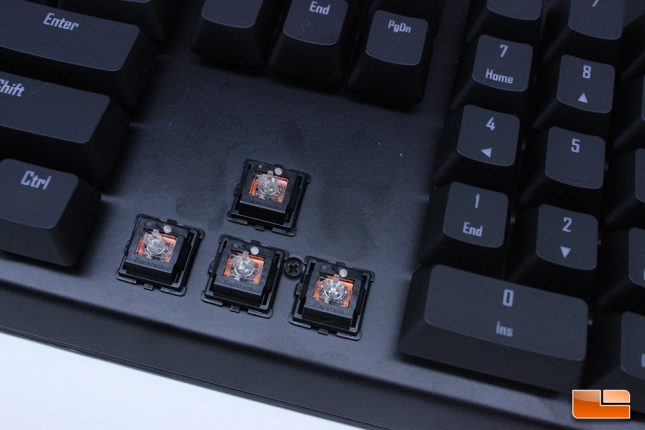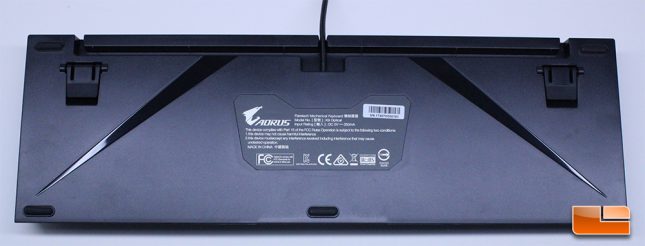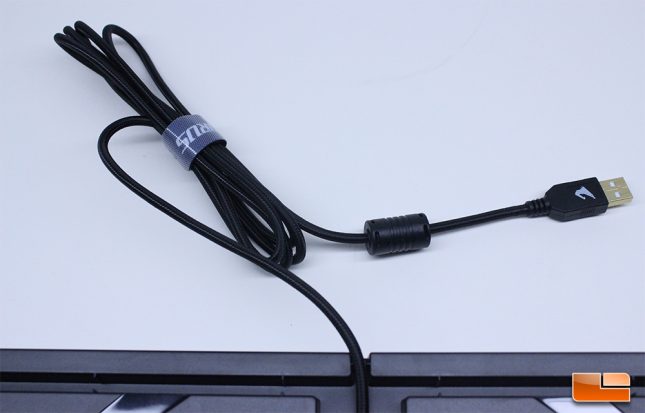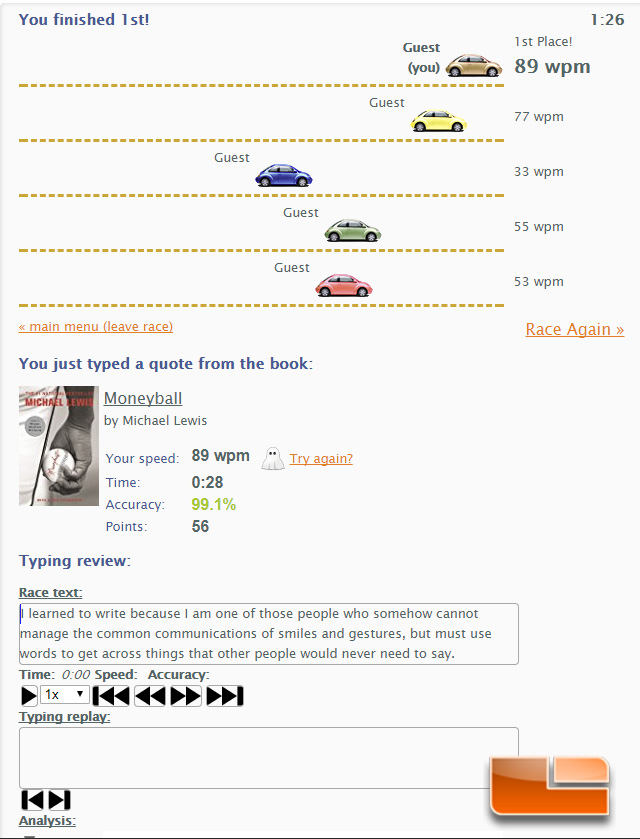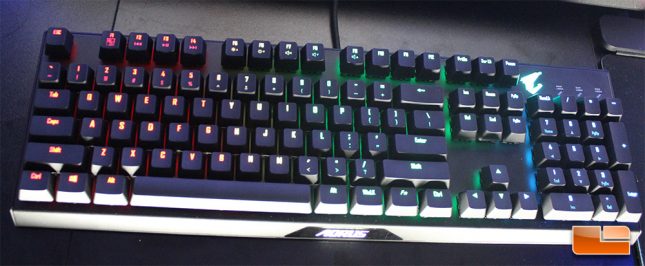Aorus K9 Optical Mechanical Keyboard Review
Aorus K9 Optical Mechanical Keyboard – A Closer Look
The black plastic frame of the Aorus K9 Optical mechanical keyboard is tight and compact, with thin bezels and a low profile rise. The switches are mounted to the surface plate of the Aorus K9 rather than being set within the frame over a backplate, which gives the key caps a floating look while allowing for easier cleaning.
The K9 Optical keyboard doesn’t pick up fingerprints or stain easily due to the coating Aorus has used on the top surface and the unit has a clean overall look, with an RGB Aorus logo to the left of the indicator lights and another light up logo the front bezel. Doing a flex test by grabbing the keyboard at the corners and twisting as hard as I can, the Aorus K9 Optical exhibited minimal flex and demonstrated solid build quality, with no quality concerns coming to light.
The ABS key caps on the Aorus K9 Optical are well made and should last for quite some time. The F-Keys on the Aorus K9 act as media keys, LED adjustment and volume controls when used in conjunction with the FN key. While the font is a bit too large for my liking, it isn’t overly obnoxious and looks decent enough. The key caps have a soft feeling to them and are okay to type on, but the corner edges of the key caps are a bit pronounced.
Removing the ABS key caps on the Aorus K9 Optical, we get a closer look at the plate-mounted Flaretech Optical switches with their clear (not actually blue) Cherry MX-compatible stem. The Flaretech switches on the K9 Optical are surface mounted and feel very secure, without any play or tolerance issues apparent across the board. Removing and replacing key caps on the Flaretech Optical switches was a smooth affair and I tried using a couple of Cherry MX keycaps with success.
The back of the Aorus K9 Optical has routing lanes for the USB cable so that it can be optically placed on your desktop. Rubber support feet are found spaced evenly through the bottom of the keyboard and Aorus is using decent quality single-step risers with a rubber base to adjust the rear height of the keyboard, which will help keep the keyboard in place when lifted.
The six foot long braided USB cable on the Aorus K9 isn’t removable and the braiding is kind of thick, which means the cable has a few kinks in it and isn’t very flexible. While the cable has a quality gold-plated USB connector with the Aorus logo and has a high quality feel, the lack of flexibility may make it a bit hard to route for aesthetic appeal on certain desks.
The Aorus K9 Optical has a solid build quality and features, let’s take a closer look at the Aorus Graphics Engine, which is used to set Macros and control lighting.
Aorus K9 Optical and Aorus Graphics Engine
The Aorus K9 Optical uses the Aorus Graphics Engine and version 1.29 was the version I used for testing of the K9 Optical. The Aorus Graphics Engine supports Aorus motherboard and graphics cards, giving users a single piece of software to control their various Aorus products. Unfortunately, I found the Aorus Graphics Engine to be a bit slow and it crashed on me a couple of times during use. The Aorus Graphics Engine allows users to adjust lighting and set macros on the K9 Optical, but other functions like polling rate adjustment, key repeat and n-key rollover toggle are not available. The lighting modes available to the motherboard under Aorus Graphics Engine are limited and Aorus currently has two pieces of software that control lighting on my motherboard, so installing them both at the same time actually caused conflicts. There are a few basic RGB lighting modes on the Aorus K9, but per-key lighting isn’t available. A music reactive mode is available and the Aorus K9 can be synchronized with the motherboard for potential seizure-inducing lighting modes.Buggy software will hurt any good peripheral and the Aorus K9 is no exception.
Aorus K9 Optical Typing and Gaming
The Aorus K9 Optical has a very solid build quality and was fine to type on, though I can’t last for long with the clicks of Blue switches filling the air. The Aorus K9 feels really solid while typing and there wasn’t any flex or movement. I was able to type at my typical average of 90 WPM on Typeracer with the Aorus K9 out of the box and felt that the keyboard was very responsive. It is pretty cool that an excerpt from Moneyball ended up being the first SpeedTest that I hit on the Aorus K9 Optical, as I am a huge Oakland A’s fan. I had no issues with key presses not registering, or double-registering on the Aorus K9 Optical and chatter was not a factor. The Flaretech Red switches, which unfortunately I only have nine of, ended up being really smooth and I will be ordering more to outfit the entire keyboard with them. A lot of typists prefer tactile switches, but I’ve really fallen in love with linear switches like the Cherry MX Silver and MX Red over the years.
Gaming on the Aorus K9 was a joy, especially once I replaced the WASD keys with the Flaretech Red switch, which offered fast, smooth linear action. The keys felt well spaced and I never had any issues with incorrectly pressing keys during game play. In general, the Aorus K9 Optical was a very solid keyboard to game on.
The Aorus K9 Optical ended up providing a solid typing and gaming experience thanks to its solid build quality and use of Flaretech switches. This is the second time I’ve used a keyboard with the Flaretech Optical switch and I have to say, I am impressed with how Aorus has implemented them on the K9 Optical, which is stylish and well-built. The RGB lighting effects on the Aorus K9 Optical look good, with even lighting distribtion across the keys. While the Aorus Graphics Engine software needs improvement, it works well enough and isn’t so bad that it keeps me from wanting to recommend the Aorus K9 Optical.
Let’s see how the Aorus K9 Optical stacks up on the next page.

